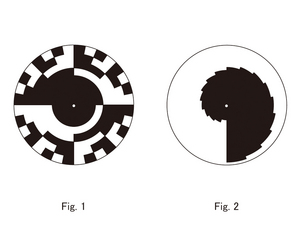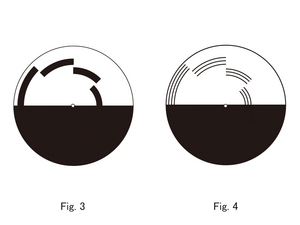Nagoya City Science Museum
TOP > Exhibition Guide > Keyword Search > Starting with "I" > Illusional Disk > Illusional Disks
Illusional Disks



Purpose of Exhibition
Turn the disks with various patterns.
You will see mysterious phenomena: colors can be seen even if a disk is black-and white, a seven-colored disk is turned into gray and others like a "Spiral Disk" and "Striped Disk". You can enjoy the illusions caused by the human eye and brain.
Additional Knowledge
Although "Benham's Top" is a top on which only black-and-white patterns are drawn, as shown in the figure, various colors can mysteriously be seen if it spins. Depending on its rotating speed, angle, lighting conditions, and observers, the colors can be seen differently. For example, tops in figures 3 and 4 are turned into, from inside of the top, reddish brown, olive green and bluish purple when spun clockwise. As turned counterclockwise, the colors come in reverse order.
It was a German physicist and psychologist, Gustav Theodor Fechner, who for the first time demonstrated that colors could be seen when a black-and-white disk rotates. Subsequently, various patterns on the disk were developed (patterns in figure 1 and 2) but when Benham had drawn the patterns for tops in figure 3 and 4 and put them on sale, they became a sensation. Since then, this mysterious phenomenon have been widely known and is called a "Benham's Top".
The reason why colors appear, when a "Benham's Top" is spun, is due to an optical illusion. Even if you take photos of the spinning disks, colors will not be taken. We do not know the reason for this, but there is the following
hypothesis:
Substances reflecting all the light of colors are sensed as being white in our eyes and they cannot be seen colored. However, in such lights, some lights with a rainbow color such as red and blue are included. It is not that our eyes react instantly to lights coming in, it delays slightly. On the contrary, when a light coming into your eyes suddenly disappears, it leaves a sense of light in your eyes for a little while. This time difference of response depends on colors. We respond to red the quickest, the second quickest is green and blue follows.
By the way, when you spin a Benham's top, the black-and-white stimulates your eyes alternatively. This is considered the same as flickering lights. Depending on how quick you respond to each color that flickers at that moment, different colors will be seen.
Article by Keiko Ishida, curator
